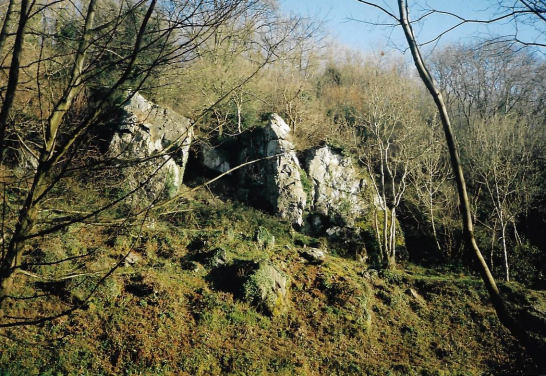Geology, mines and quarries
by Tim Deane
Rocks
The strata that underlie the middle Teign Valley were mostly formed on the sea floor from sediments deposited during the late Devonian and succeeding Carboniferous geological periods. (Devonian 420 to 360 million years ago, the period that saw the slow development of plant life on land and the beginnings of the evolution of amphibian animals; Carboniferous 360 to 290 million years ago - the coming of trees, insects and the first reptiles). The Devonian and Lower Carboniferous rocks are mudstones and shales formed of compressed mud and clay, and cherts – a harder silicaceous stone derived from eroded quartzite and the exoskeletons of radiolaria (microscopic marine plankton). Also of this period are rocks of volcanic origin, resulting from deposits of both lava and ash. The Upper Carboniferous rocks are again rich in mudstones, but with a sizable admixture of fine-grained sandstones.
The Variscan movement
In late Carboniferous times a mountain building movement in the Earth’s crust, known as the Variscan Orogeny, thrust the rocks of what is now SW England against the resistant mass of the older Welsh rocks so that they were folded and pushed up into a mountain range. Locally this has resulted in narrow bands of different rocks lying at a variety of angles to the horizontal, sometimes so radically folded that the older rock overlies the younger. Interspersed between some of these bands are ribbons of dolerite, a hard and (like granite) an igneous rock derived from the molten magma below the Earth’s crust which found its way into the deep layers of existing rock early in the process of upheaval.

Granite
Most obvious of the geological features are the granite plateau and its escarpment to the west of the Teign. The Dartmoor granite results (for the most part) from a single phase of intrusion towards the end of the Carboniferous period. Like a gigantic blister the molten rock intruded into the base of the newly formed mountains, set off perhaps by a weakness in the crust caused by the folding movement. It cooled and solidified under pressure deep below the surface, only coming to light some 250 million years later – the covering of Devonian and Carboniferous rocks having been eroded away in that time.
Baked rocks and minerals
As well as contributing to the local upheaval of the strata, the granite intrusion, through its intense heat, baked the rocks with which it came into close contact, radically altering their nature through recrystallisation. This process created the dense elvans and other hardened rocks which make up much of the narrow Metamorphic Aureole surrounding the granite of Dartmoor. A further effect was that mineral-laden gasses and fluids associated with the granite found their way into faults in the native rock, depositing the minerals as they cooled. A significant mineralised zone not much more than 200 m. wide runs for 8 km. along the outer limit of the aureole, from northeast of Bridford to south of Teign Village, its main ores being silver, lead and zinc.
Later periods
Going east over the Haldon ridge you see spread below you the fertile red lands formed from deposits of the Permian period that succeeded the Carboniferous, but evidence of this and later geological periods is lacking or scarce in the Teign Valley itself. However, the clay pits east of Bridford road take us on to the Oligocene, about 40 million years ago. These excavations exploited a small deposit, contemporary with the ball clay of the Bovey Basin.
Ice
A much later contributor to the pre-human landscape was ice - the last Ice Age having ended only about 11,000 years ago. Although the south of England was never glaciated, the conditions just off the ice sheet would have resembled arctic Canada or Spitzbergen today. The effect of countless cycles of thawing and freezing can be seen out on the moor where the formerly much mightier granite tors have been shattered and had their rock spread over large areas in fields of ‘clitter’. The spread resulted from a layer of brief summer mud acting as a lubricant above the deeply frozen and thus impermeable ground, a process called solifluction. The same effect caused boulders of elvan to litter the area for some distance beneath Skat Tor, the easternmost tor on Dartmoor before being quarried away in the late 1940s. Known also as Scatter Rock it stood on the boundary of Christow and Bridford.
That bit of the earth’s crust which is our home crossed the equator on its steady northward progress 300 million years ago. ‘Our’ rocks have at different times been pushed up and cast down, worked on by freezing winds and hot storms of sand. They’ve been covered up by other newer rock, layer by layer, and then exposed again. Here and there they’ve been scoured by mighty rivers. They’ve made both a seabed and been part of a mountain range. In all this, human existence is no more than the blink of an eye and it’s difficult to relate our present life to the vast weight of geological time and the changes which it has wrought. Even so the facts of geology and the results of its processes have always played a large part in the working life of the district. This was especially so during the mineral boom of part of the 19th and much of the 20th centuries but is reflected also in its buildings and farming economy.